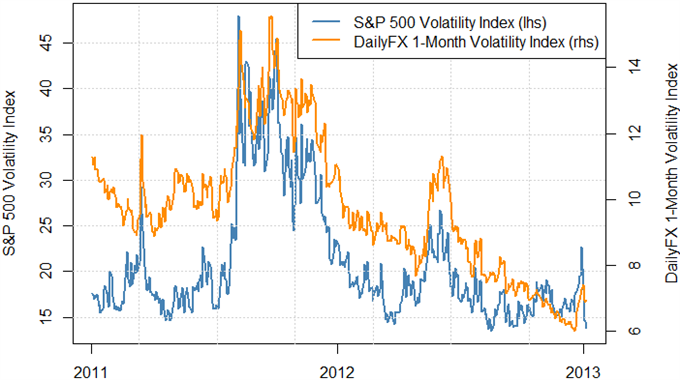Article Summary: A sharp drop in the S&P 500 Volatility Index suggests financial markets may quiet down in the days ahead, but strong US Dollar trends offer momentum-trading opportunities. Japanese Yen options show that traders nonetheless predict strong JPY moves through the foreseeable future.
DailyFX PLUS System Trading Signals ?A drop in the S&P 500
A deal on the Fiscal Cliff produced a significant lull in financial market volatility, and the S&P 500 Volatility Index now trades near its lowest levels since 2007. The sharp drop in the so-called ?Fear Index? suggests that risky assets may be well-supported through the foreseeable future, but it?s interesting to note that forex market volatility expectations have not seen a similar plunge.
In effect this tells us that major currency pairs may continue to see sizeable swings in the coming week. The Dow Jones FXCM Dollar Index trades at its highest levels since July, and such price momentum leaves us in favor of trend-following FX trading systems.
DailyFX 1-Month Volatility Index versus S&P 500 Volatility Index (VIX) 2011 ? Present

Past performance is not indicative of future results, but our ?Momentum2/Tidal Shift? system has recently seen outperformance in key US Dollar pairs?particularly the EURUSD, USDJPY, and AUDUSD. The performance of said system is quite streak-prone; it typically does well or poorly for extended periods of time. Said dynamic means it is our preferred strategy for the USD.
Japanese Yen Implied Volatility Expectations Remain Elevated

The Japanese Yen is the one currency that has defied the most recent drop in financial market volatility, and indeed implied volatility expectations trade at multi-month highs across all JPY pairs. In effect this leaves us in favor of the high-volatility ?Breakout Opportunities/Breakout2? strategy for the USDJPY and other Yen-denominated pairs.
DailyFX Individual Currency Pair Conditions and Trading Strategy Bias

? Written by David Rodriguez, Quantitative Strategist for DailyFX.com
To receive the Speculative Sentiment Index and other reports from this author via e-mail, sign up to David?s e-mail distribution list via this link.
Contact David via
Twitter at http://www.twitter.com/DRodriguezFX
Facebook at http://www.Facebook.com/DRodriguezFX
New to forex? Sign up for our DailyFX Forex Education Series
Definitions
Volatility Percentile ? The higher the number, the more likely we are to see strong movements in price. This number tells us where current implied volatility levels stand in relation to the past 90 days of trading. We have found that implied volatilities tend to remain very high or very low for extended periods of time. As such, it is helpful to know where the current implied volatility level stands in relation to its medium-term range.
Trend ? This indicator measures trend intensity by telling us where price stands in relation to its 90 trading-day range. A very low number tells us that price is currently at or near 90-day lows, while a higher number tells us that we are near the highs. A value at or near 50 percent tells us that we are at the middle of the currency pair?s 90-day range.
Range High ? 90-day closing high.
Range Low ? 90-day closing low.
Last ? Current market price.
Bias ? Based on the above criteria, we assign the more likely profitable strategy for any given currency pair. A highly volatile currency pair (Volatility Percentile very high) suggests that we should look to use Breakout strategies. More moderate volatility levels and strong Trend values make Momentum trades more attractive, while the lowest Vol Percentile and Trend indicator figures make Range Trading the more attractive strategy.
HYPOTHETICAL PERFORMANCE RESULTS HAVE MANY INHERENT LIMITATIONS, SOME OF WHICH ARE DESCRIBED BELOW. NO REPRESENTATION IS BEING MADE THAT ANY ACCOUNT WILL OR IS LIKELY TO ACHIEVE PROFITS OR LOSSES SIMILAR TO THOSE SHOWN. IN FACT, THERE ARE FREQUENTLY SHARP DIFFERENCES BETWEEN HYPOTHETICAL PERFORMANCE RESULTS AND THE ACTUAL RESULTS SUBSEQUENTLY ACHIEVED BY ANY PARTICULAR TRADING PROGRAM.
ONE OF THE LIMITATIONS OF HYPOTHETICAL PERFORMANCE RESULTS IS THAT THEY ARE GENERALLY PREPARED WITH THE BENEFIT OF HINDSIGHT. IN ADDITION, HYPOTHETICAL TRADING DOES NOT INVOLVE FINANCIAL RISK, AND NO HYPOTHETICAL TRADING RECORD CAN COMPLETELY ACCOUNT FOR THE IMPACT OF FINANCIAL RISK IN ACTUAL TRADING. FOR EXAMPLE, THE ABILITY TO WITHSTAND LOSSES OR TO ADHERE TO A PARTICULAR TRADING PROGRAM IN SPITE OF TRADING LOSSES IS MATERIAL POINTS WHICH CAN ALSO ADVERSELY AFFECT ACTUAL TRADING RESULTS. THERE ARE NUMEROUS OTHER FACTORS RELATED TO THE MARKETS IN GENERAL OR TO THE IMPLEMENTATION.
OF ANY SPECIFIC TRADING PROGRAM WHICH CANNOT BE FULLY ACCOUNTED FOR IN THE PREPARATION OF HYPOTHETICAL PERFORMANCE RESULTS AND ALL OF WHICH CAN ADVERSELY AFFECT ACTUAL TRADING RESULTS. Any opinions, news, research, analyses, prices, or other information contained on this website is provided as general market commentary, and does not constitute investment advice. The FXCM group will not accept liability for any loss or damage, including without limitation to, any loss of profit, which may arise directly or indirectly from use of or reliance contained in the trading signals, or in any accompanying chart analyses.
Source: http://allyalls.com/forex-strategy-dollar-offers-trend-trading-jpy-shows-breakouts.html
the maldives harper lee mega millions numbers the fray seahawks new uniforms 2012 tornadoes in dallas anchorman 2
No comments:
Post a Comment
Note: Only a member of this blog may post a comment.